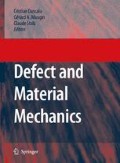Abstract
This paper deals with energy based r-adaptivity in finite hyperelastostatics. The focus lies on the development of a numerical solution strategy. Although the concept of improving the accuracy of a finite element solution by minimizing the discrete potential energy with respect to the material node point positions is well-known, the numerical implementation of the underlying minimization problem is difficult. In this paper, energy based r-adaptivity is defined as a minimization problem with inequality constraints. The constraints are introduced to restrict the maximum distortion of the finite element mesh. As a solution strategy for the constrained problem, we use a classical barrier method. Beside the theoretical aspects and the implementation, a numerical experiment is presented. We illustrate the performance of the proposed r-adaptivity in the case of a cracked specimen.
Access this chapter
Tax calculation will be finalised at checkout
Purchases are for personal use only
Preview
Unable to display preview. Download preview PDF.
References
Armero F and Love E (2003). An arbitrary Lagrangian–Eulerian finite element method for finite strain plasticity. Int J Numer Meth Eng 57: 471–508
Askes H, Kuhl E and Steinmann P (2004). An ALE formulation based on spatial and material settings of continuum mechanics. Part 2: classification and applications. Comput Methods Appl Mech Eng 193: 4223–4245
Bathe KJ and Sussman TD (1983). An algorithm for the construction of optimal finite element meshes in linear elasticity. Comput Methods Nonlinear Solids Struct Mech 54: 15–36 ASME, AMD
Bertsekas DP (1995). Nonlinear programming. Athena Scientific, Belmont, MA
Braun M (1997). Configurational forces induced by finite-element discretization. Proc Estonian Acad Sci Phys Math 46: 24–31
Carpenter WC and Zendegui S (1982). Optimum nodal locations for a finite element idealization. Eng Optim 5: 215–221
Carroll WE and Barker RM (1973). A theorem for optimum finite-element idealizations. Int J Solids Struct 9: 883–895
Felippa CA (1976a). Numerical experiments in finite element grid optimization by direct energy search. Appl Math Model 1: 239–244
Felippa CA (1976b). Optimization of finite element grids by direct energy search. Appl Math Model 1: 93–96
Gill PE, Murray W, Wright MH (1981) Practical optimization. Academic Press
Holzapfel GA (2000). Nonlinear solid mechanics. Wiley, Chichester
Hughes TJR (1987). The finite element method. Dover Publications, New York
Jarre S (2004). Optimierung. Springer-Verlag, Berlin
Knupp PM (2000a). Achieving finite element mesh quality via optimization of the Jacobian matrix norm and associated quantities. Part I – a framework for surface mesh optimization. Int J Numer Meth Eng 48: 401–420
Knupp PM (2000b). Achieving finite element mesh quality via optimization of the Jacobian matrix norm and associated quantities. Part II – a framework for volume mesh optimization and the condition number of the Jacobian matrix. Int J Numer Meth Eng 48: 1165–1185
Kuhl E, Askes H and Steinmann P (2004). An ALE formulation based on spatial and material settings of continuum mechanics. Part 1: generic hyperelastic formulation. Comput Methods Appl Mech Eng 193: 4207–4222
Luenberger DG (1973). Introduction to linear and nonlinear programming. Addison-Wesley Publishing Company, Reading
Marsden JE and Hughes TJR (1983). Mathematical foundations of elasticity. Dover Publications, New York
McNeice GM and Marcal PV (1973). Optimization of finite element grids based on minimum potential energy. Trans ASME J Eng Ind 95(1): 186–190
Mosler J and Ortiz M (2006). On the numerical implementation of varational arbitrary Lagrangian–Eulerian (VALE) formulations. Int J Numer Meth Eng 67: 1272–1289
Mueller R and Maugin GA (2002). On material forces and finite element discretizations. Comput Mech 29: 52–60
Mueller R, Kolling S and Gross D (2002). On configurational forces in the context of the finite element method. Int J Numer Meth Eng 53: 1557–1574
Mueller R, Gross D and Maugin GA (2004). Use of material forces in adaptive finite element methods. Comput Mech 33: 421–434
Rajagopal A, Gangadharan R and Sivakumar SM (2006). On material forces and finite element discretizations. Int J Comput Meth Eng Sci Mech 7: 241–262
Steinmann P, Ackermann D and Barth FJ (2001). Application of material forces to hyperelastostatic fracture mechanics. Part II: computational setting. Int J Solids Struct 38: 5509–5526
Sussman T and Bathe KJ (1985). The gradient of the finite element variational indicator with respect to nodal point co–ordinates: an explicit calculation and application in fracture mechanics and mesh optimization. Int J Numer Meth Eng 21: 763–774
Thoutireddy P (2003) Variational arbitrary Lagrangian–Eulerian method. Ph.D. Thesis, California Institute of Technology, Passadena, California
Thoutireddy P and Ortiz M (2004). A variational r-adaption and shape-optimization method for finite-deformation elasticity. Int J Numer Meth Eng 61: 1–21
Wriggers P (2001). Nichtlineare finite-element-methoden. Springer-Verlag, Berlin
Author information
Authors and Affiliations
Corresponding author
Editor information
Editors and Affiliations
Rights and permissions
Copyright information
© 2007 Springer Science+Business Media B.V.
About this paper
Cite this paper
Scherer, M., Denzer, R., Steinmann, P. (2007). Energy-based r-adaptivity: a solution strategy and applications to fracture mechanics. In: Dascalu, C., Maugin, G.A., Stolz, C. (eds) Defect and Material Mechanics. Springer, Dordrecht. https://doi.org/10.1007/978-1-4020-6929-1_12
Download citation
DOI: https://doi.org/10.1007/978-1-4020-6929-1_12
Publisher Name: Springer, Dordrecht
Print ISBN: 978-1-4020-6928-4
Online ISBN: 978-1-4020-6929-1
eBook Packages: EngineeringEngineering (R0)

